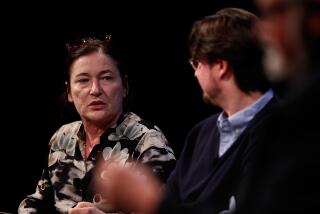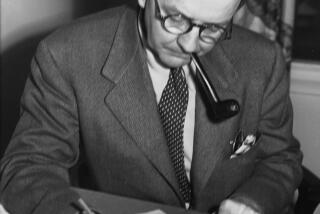A poet restored to rustic glory
- Share via
In the fall of 1840, Alfred Tennyson invested 1,000 pounds in a scheme to develop a steam-powered woodcarving machine. Three of his sisters put up 4,000 pounds more for this Pyroglyph, and Tennyson promised an additional 2,000 pounds, so persuasive was its inventor, Dr. Matthew Allen, proprietor of the High Beech insane asylum, where Tennyson was a sometimes patient. The venture bankrupted Allen and most of the Tennyson family.
That summer, Allen had concocted another scheme, ostensibly on behalf of a poet “in residence.” According to a letter Allen published in the London Times, when John Clare was admitted to High Beech in 1837, “his mind did not appear so much lost and deranged as suspended in its movements by the oppressive and permanent state of anxiety, and fear, and vexation, produced by the excitement of excessive flattery at one time and neglect at another, his extreme poverty and over-exertion of body and mind.” Allen asked charitable readers to fund an annuity to relieve Clare of his poverty, to ease and, by implication, heal his mind. All money raised went directly to Allen.
Clare never had the investment options Tennyson had. Born July 13, 1793, one year after Shelley and two before Keats, Clare was the poorest, least educated and most countrified exemplar of the Romantic period. Once, perhaps coyly, he asked why other poets wrote so much about the nightingale and the cuckoo and never about the yellowhammer and the pettichap. This is how Clare’s yellowhammer, a small British finch, makes its house:
Rude is the nest this architect invents,
Rural the place, wi’ cart-ruts by dyke-side;
Dead grass, horse hair and downy-headed bents
Tied to dead thistles she doth well provide ...
“Bents” are the flowerstalks of certain weeds, like the dandelion. Clare’s obsessive eye for details differentiates dead grass from dead weeds, and weeds from dead thistles. The thorny consonants (“tied to dead thistles”) and precision of these lines give the lie to other poets’ sentiments. Where Wordsworth considered his “Solitary Reaper” from a distance -- “Behold her, single in the field / Yon solitary Highland Lass!” -- Clare, a thresher himself, plopped the rural damsel directly onto his lap--”round her slender waist I fling my arms”--and desires to palpably “bear her weight through all eternity.”
The public embraced Clare because he was a bumpkin: In the jargon of the day, a clown. His publishers marketed his first and most successful book, “Poems, Descriptive of Rural Life and Scenery,” as the work of a naif. A patron published a picturesque preview, describing a visit from Clare: “There was a carpet, upon which it is likely he never previously set foot; and wine, of which assuredly he had never tasted before.”
As Jonathan Bate writes in “John Clare: A Biography,” “this is nonsense.” Clare is generally considered a minor, albeit beloved, poet; Bate’s biography does not strain to boost his reputation so much as to straighten it: “Because Clare was perceived as an anomaly within his culture, there was always a tendency to attach labels to him: mad poet took over where peasant poet left off.” Bate’s intelligence is sane and leveling, suited to a biography that could otherwise have become a caricature.
Clare never made more than 40 pounds from a book of poems. Even at the height of literary fame, he had to labor, like “a hind born to the flail and plough, / To thump the corn out and to till the earth.” Clare had schooling until age 13, and he resented grammar, which was generally taught only to upper-class students of Latin: “grammer [sic] in learning is like Tyranny in government,” he once wrote to his publisher.
But Clare was not ignorant. He wrote within the tradition of James Thomson and Lord Byron. His resistance to writing “in the teeth of grammer” was as political as it was practical.
The dissonance between Clare’s background and that of other literary men led to conflict. His wealthy patrons were often dismayed by Clare’s frank treatment of enclosure, whereby the common fields that villagers worked were divided and made private property in the modern sense. One Lord Radstock, on examining a soon-to-be published manuscript, demanded that certain stanzas containing “radical Slang” be excised.
There once were lanes in nature’s freedom dropt,
There once were paths that every valley wound, --
Inclosure came, and every path was stoppt;
Each tyrant fix’d his sign where paths were found....
Lanes and paths took their natural course, according to topography and convenience, but enclosure, with its fences, interrupted the peasant’s habitual relationship with the land. German philosopher Walter Benjamin would later write that an ideal way to appreciate architecture was not to look at a building from across the street but by “tactile appropriation,” to walk up and down its staircases every day. When Clare’s boyhood walks became impossible, he was alienated from his native countryside.
Bate, who has written extensively on “ecopoesis” in his book “The Song of the Earth,” is happy to suggest that Clare was an ecological poet. But his relationship to nature was always more personal than political. In the introduction to Clare’s first book, his publisher, John Taylor, wrote, “He is happier in the presence of Nature than elsewhere. He looks anxiously on her face as if she were a living friend, whom he might lose.” In a late poem, written a short time before he was committed, Clare wrote about trespassing on private property as if it were a guilty tryst:
And when I gained the road where all are free
I fancied every stranger frowned at me
And every kinder look appeared to say
‘You’ve been on trespass in your walk today.’
Clare’s anthropomorphic loneliness for lost land was telling: Besides nature, his greatest muse was a childhood love, Mary Joyce. Through a lifelong marriage to “Patty” Turner, as well as at least two affairs, Clare remembered Mary. As he lost his mind, he began to believe that he was married to both Patty and Mary. Even after Mary’s death was reported to him, he was confused by her absence, as in “To Mary”:
I sleep with thee and wake with thee
And yet thou art not there;
I fill my arms with thoughts of thee
And press the common air.
Bate downplays the specificity of Mary the muse. Besides muffling adulterous memories, Mary was simply another aspect of Clare’s taste for loss. As poet Arthur Symons, one of Clare’s first modern champions, writes, “what killed him as a human mind exalted him as a poetic consciousness.”
Clare was a compulsive man. Bate, duly noting that posthumous diagnosis is a dangerous game, reckons that Clare was bipolar. In what might be called his manic phases, he wrote with alarming speed: “The clutter, insertions and erasures in Clare’s manuscripts are an editor’s nightmare.” Critics have claimed that his editors’ failure to fully encourage and support Clare, after an English vogue for poetry waned in the 1830s, contributed to his mental collapse. But Bate defends them: “[T]he handling of Clare was probably the most delicate and time-consuming literary task of their publishing partnership.” Bate has edited “ ‘I Am’: The Selected Poetry of John Clare” to accompany his biography. In it, he reasonably preserves many of Clare’s publishers’ corrections, contrary to recent trends in Clare scholarship.
Bate’s understated manner and tendency to de-romanticize Clare’s life spring from his quarrel with “the myth of solitary genius.” In defending his publishers, contextualizing Clare’s obsessions and describing the educational advantages Clare had over other peasants, Bate makes Clare’s biography safe for his poetry. “Clare’s genius was exceptional, but his ‘madness’ was not.” The poet that emerges is frail and restless, ambitious, impressionable and finally disappointed by the reception that his contemporaries, lacking Bate’s tact and hindsight, gave him. So he wrote from the asylum, in the famous “Lines: ‘I Am’ ”:
I am -- yet what I am, none cares or knows;
My friends forsake me like a memory lost:
I am the self-consumer of my woes --
More to Read
Sign up for our Book Club newsletter
Get the latest news, events and more from the Los Angeles Times Book Club, and help us get L.A. reading and talking.
You may occasionally receive promotional content from the Los Angeles Times.










